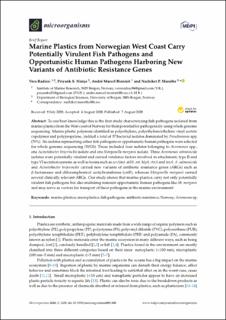| dc.contributor.author | Radisic, Vera | |
| dc.contributor.author | Nimje, Priyank Sharad | |
| dc.contributor.author | Bienfait, André Marcel | |
| dc.contributor.author | Marathe, Nachiket | |
| dc.date.accessioned | 2021-06-07T11:52:53Z | |
| dc.date.available | 2021-06-07T11:52:53Z | |
| dc.date.created | 2020-09-27T19:35:20Z | |
| dc.date.issued | 2020 | |
| dc.Published | Microorganisms. 2020, 8:1200 (8), 1-13. | |
| dc.identifier.issn | 2076-2607 | |
| dc.identifier.uri | https://hdl.handle.net/11250/2758205 | |
| dc.description.abstract | To our best knowledge this is the first study characterizing fish pathogens isolated from marine plastics from the West coast of Norway for their potential for pathogenicity using whole genome sequencing. Marine plastic polymers identified as polyethylene, polyethylene/ethylene vinyl acetate copolymer and polypropylene, yielded a total of 37 bacterial isolates dominated by Pseudomonas spp. (70%). Six isolates representing either fish pathogens or opportunistic human pathogens were selected for whole genome sequencing (WGS). These included four isolates belonging to Aeromonas spp., one Acinetobacter beijerinckii isolate and one Morganella morganii isolate. Three Aeromonas salmonicida isolates were potentially virulent and carried virulence factors involved in attachment, type II and type VI secretion systems as well as toxins such as aerA/act, ahh1, ast, hlyA, rtxA and toxA. A. salmonicida and Acinetobacter beijerinckii carried new variants of antibiotic resistance genes (ARGs) such as β-lactamases and chloramphenicol acetyltransferase (catB), whereas Morganella morganii carried several clinically relevant ARGs. Our study shows that marine plastics carry not only potentially virulent fish pathogens but also multidrug resistant opportunistic human pathogens like M. morganii and may serve as vectors for transport of these pathogens in the marine environment. | en_US |
| dc.language.iso | eng | en_US |
| dc.publisher | MDPI | en_US |
| dc.rights | Navngivelse 4.0 Internasjonal | * |
| dc.rights.uri | http://creativecommons.org/licenses/by/4.0/deed.no | * |
| dc.title | Marine Plastics from Norwegian West Coast Carry Potentially Virulent Fish Pathogens and Opportunistic Human Pathogens Harboring New Variants of Antibiotic Resistance Genes | en_US |
| dc.type | Journal article | en_US |
| dc.type | Peer reviewed | en_US |
| dc.description.version | publishedVersion | en_US |
| dc.rights.holder | Copyright 2020 by the authors | en_US |
| dc.source.articlenumber | 1200 | en_US |
| cristin.ispublished | true | |
| cristin.fulltext | original | |
| cristin.qualitycode | 1 | |
| dc.identifier.doi | 10.3390/microorganisms8081200 | |
| dc.identifier.cristin | 1833871 | |
| dc.source.journal | Microorganisms | en_US |
| dc.source.40 | 8:1200 | |
| dc.source.14 | 8 | |
| dc.relation.project | Havforskningsinstituttet: 15495 | en_US |
| dc.identifier.citation | Microorganisms. 2020, 8 (8), 1200. | en_US |
| dc.source.volume | 8 | en_US |
| dc.source.issue | 8 | en_US |

